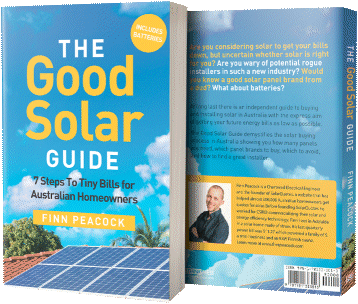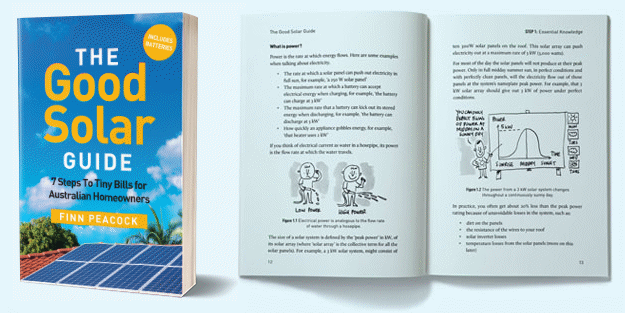
Thanks to the federal battery rebate and multiple state incentives, many new battery owners will soon be wondering if they should join a Virtual Power Plant (VPP). While the pros can make it worthwhile, you have to look out for a huge list of cons before signing up.
Last week, I wrote about how the payments and potentially other benefits from joining a VPP, which is a network of solar power and battery systems coordinated by a central operator, can make it worthwhile. This week, I’m writing about the multiple difficulties, issues, and outright traps you may need to deal with or dodge when joining one. But before I go into various VPP problems — and boy, are there a lot of them — I will ask you to do one thing …
So long as there is a decent VPP available in your area that accepts your battery and doesn’t have the goal of screwing customers over, then after joining you shouldn’t have any worries beyond deciding how to spend your meagre payments and checking every year or so to ensure it hasn’t become a bad VPP and is ripping you off in relation to what else is available.
But you will need to carefully check that it is a decent VPP.
VPP Problems
Problems with VPPs include:
- A lack of choice — including no choice at all in TAS and NT.
- Each VPP generally only accepts a limited range of batteries.
- Even if they accept your battery, a VPP can knock you back if they don’t like its capacity or the capacity of your solar system.
- With most VPPs — but not all — you’ll no longer have full control over your battery.
- VPPs lock you into one electricity retailer.
- There can be expensive hidden “gotchas” in their terms & conditions.
- VPPs increase wear and tear on your battery.
Now the federal battery rebate is available and states like NSW and WA are offering VPP-linked incentives, I expect — or at least hope — most of these problems will diminish as more VPPs appear, existing ones increase their coverage, and competition for customers causes them to improve their terms.
Limited Choice
The first major hurdle to joining a VPP is there’s not a lot of choice, with what’s available depending on where you are:
- Some choice: ACT, NSW, QLD, SA, and VIC
- Very limited choice: WA
- No choice: TAS, NT
But even in the locations where there’s some choice, options can be limited — or disappear entirely — outside of major cities. WA has very limited choice, but at least — so long as you are on-grid — there will be a state-provided VPP available. In Tasmania and the NT, you’re currently out of luck because, as far as I know, no VPPs are available.
VPP choice is further constrained because they usually only accept certain types of batteries. But even if you have a battery they use, they can still reject you if they don’t like your battery’s capacity or even the capacity of your solar system.
This means you can go through the trouble of getting a VPP-capable battery installed — which the federal battery rebate requires — and still be unable to join a VPP because none are available, you don’t have the right battery, or a VPP simply don’t like the details of your system.
But despite the difficulty of joining a VPP, what I don’t recommend doing — unless there’s one you’re desperate to join — is buying a battery to match VPP requirements. Instead, buy the best battery you can that suits your needs and budget, and then cross your fingers and hope suitable VPPs become available. As the number of battery owners begins to rapidly rise, I expect VPPs will become far more flexible.
VPPs Can Make You Lose Control
Join most VPPs and you’ll no longer have full control over your battery. When it suits their purposes, VPP operators can remotely charge or discharge your battery to support the grid.

It’s important to find a VPP that suits your purposes. Finding one that suits your porpoises will be more difficult.
Normally, VPPs are limited in how much they can yank on your battery’s puppet strings and make it dance for their benefit. Some may only be allowed to discharge a set amount of energy per year, such as 200kWh. Others may limit it to a number of “cycles” per year, such as 30, with a cycle being the maximum amount of usable energy it can discharge, less whatever reserve amount they may leave to prevent you being stuck with a flat battery if a blackout occurs.
Most VPPs that can drain your battery will leave a reserve. The typical amount is 20% but it can depend on what type of battery you have. You may also be allowed to set whatever reserve you like. Blackouts are rare in major towns and cities, but it will be very annoying if you have a battery that can provide backup power, but can’t use it because your VPP drained your battery just before it occurred.
There are a couple of VPPs that will never drain your battery remotely and leave all discharging decisions up to you. These are Amber and Glowbird Energy VPP. Because they don’t directly control your battery, some may not consider them VPPs, but the NSW government says they are for the porpoise of receiving a VPP payment, and that’s good enough for me.
VPPs Using Your Battery Can Cost You Money
Some VPPs offer payments for remotely charging your battery, but don’t mention that you have to pay to replace the energy they use. For example, you may receive $1 for every kWh they discharge from your battery, which may sound like a good deal, but if it means you have to replace it with 1kWh of grid electricity during the peak period on a time-of-use tariff, that could cost you 70c on some electricity plans. This means you’d only be coming out 30c ahead — before accounting for battery wear and tear.
You might think if your VPP has a limit on how many kWh or cycles can be discharged, it would also limit how much you have to pay to replace the lost energy. But one dirty trick some VPPs have used is to offer a payment for discharging a battery which is more than high enough to cover the cost of any grid electricity used to charge it, but then they often charge the battery with grid electricity while only discharging it when it suits them. One person found their battery was being charged with around 3kWh of grid electricity — which they paid for — for every 1kWh that was discharged and they were given a payment for.
While some VPPs guarantee you won’t be out of pocket due to their remote control discharging, and others will cap the amount so you’ll only lose a maximum of $50 per year, some will just hope you won’t realise you’re losing money this way.
Hidden “Gotchas”
If a VPP doesn’t make it clear that you’ll lose money when they discharge your battery to the grid, that’s a type of hidden “gotcha” — something which reduces the value of joining a VPP that they don’t clearly state. Some of these can be found by carefully reading the terms & conditions documents, while others can be almost impossible to spot unless you’re already familiar with how batteries work.
An example of a well-hidden gotcha potentially occurs with the Glowbird Energy VPP, where they promise to pay $1 if you don’t use grid electricity for a set 2-hour period in the evening. This is something that sounds like it should be easy for a home with a decent battery, but if you look at the details, it only applies if less than 0.06kWh of grid electricity is used during the 2-hour period. Because battery systems don’t respond instantly and perfectly to changes in demand, households with them often still draw very small amounts of grid electricity. This means many battery households may only be able to get the $1 credit in the middle of summer, when their solar systems will still be producing a trickle of electricity during the period when the $1 credit is available. But some good news is, I’ve heard from the owner of three Tesla Powerwall 2s that they have no problem getting the $1 credit in the middle of winter, so hopefully others can as well.
VPPs Lock You Into One Retailer
If you join a VPP, you have to use its associated Electricity Retailer. In WA, this doesn’t matter because there’s no retailer choice, but in other locations, this means you won’t be able to change retailers if one offers a better plan, unless you’re willing to give up your VPP. To avoid being locked into an unhappy relationship, I recommend avoiding VPPs with long contract periods or penalties for quitting early.
VPPs Can Increase Battery Wear & Tear
If a VPP discharges your battery to the grid, you may not only have to pay to replace that energy, but it also increases wear and tear on your battery.
But I say don’t worry too much about this.
If you pay $10,000 for a battery with a warranty that covers discharging 30,000kWh, you may think discharging 1kWh costs you 33c because $10,000 ÷ 30,000 = 33c. But there are a few reasons why this isn’t the right way to think about it. Firstly, your battery is unlikely to immediately die the day its warranty is over. More importantly, once you’ve paid for a battery, you may as well use it. It will eventually die at some point, but it may be for reasons completely unrelated to battery wear and tear, so — to some extent — it’s use it or lose it.
But the most important reason not to worry much about wear and tear is that when your battery is eventually replaced — hopefully after more than 15 years — replacement batteries should be far cheaper than they are now. So you shouldn’t value wear and tear on current battery costs, but what you think they’ll be in the future.
So while it makes sense to place some value on wear and tear, keep it low. Just 5c per kWh may be enough.

Battery wear and tear is no joke — unless, of course, you give the battery googly eyes and make it say something stupid.
VPP Payments Aren’t High
Years ago, for my own amusement, I estimated how much money a VPP could make from a home battery. The answer was more than they offer now. But unless you want to start your own VPP, you have to take what you can get. It’s like what my dad used to say, “Beggers can’t be bruisers, because then they’d be muggers.”
Working out just how much money you’ll make from joining a VPP is very difficult to determine. This is because they have so many different ways of paying people, which can include:
- Sign-up bonuses
- Fixed quarterly or monthly payments
- Payments per kWh discharged by the VPP
- Payments per kWh that battery owners voluntarily discharge to the grid
- Payments for not using grid electricity during specified periods
- Periods of free grid electricity
- Above-average solar feed-in tariffs
- Discounts on batteries — but these may come off an already inflated price
A single VPP may use several of these. This not only makes it difficult to work out how much a VPP will save you, it’s also difficult to compare them to see which is best. As a rule of thumb, you can expect joining a VPP to save, very roughly, around $200 per year. But this is not a sure thing. All you can do is look into which VPPs are available to you and, provided there’s more than one, weigh them up as best you can and make your choice. You may be fortunate and get one that really suits you… Or you may not.

I’m not saying a $200 VPP payment hits like a slice of lemon wrapped around a large gold brick, but it’s better than a kick in the eye from a blind horse.
How To Protect Yourself
Protecting yourself from lousy VPPs can be difficult because, for most people, they’re an unfamiliar product. But there are important steps you can take to protect yourself:
- Carefully read the terms and conditions: Take notes and keep going through them until you’re confident you understand all the ways you will be paid and all the ways you may have to pay.
- Check with VPP representatives it works the way you expect: They are obligated to give you correct information and also obligated to live up to any verbal promises or guarantees given.
- Check reviews: We’ll be sure to get some up once we try out some ourselves or find VPP beneficiaries or victims who want to tell their tale.
If these three steps aren’t enough and you end up with a lousy or downright dishonest VPP, then you can fall back on the protection provided by Australian Consumer Guarantees. Unfortunately, electricity retailers often act like consumer law doesn’t apply to them. Sometimes it definitely looks like it doesn’t. But — and this is an important point — it should apply, and — if necessary — you can seek help from consumer affairs or fair trading in your state or territory.
I’ll leave you with this potentially useful but uninspiring piece of advice — don’t expect too much. You may be better off with a VPP that offers modest payments but doesn’t have much downside, rather than one that appears to promise more but has terms and conditions that could be used to your detriment.
For more on VPPs, read our explainer on how they work, last week’s article on how government incentives make them worthwhile, and our VPP comparison table.


 RSS - Posts
RSS - Posts



An even bigger can-o-worms with EV V2G coming….
Personally, from what I’ve seen of VPP offers, I’d rather keep managing a battery to the best effect to eliminate of at least minimise bill cost.
I’ve been watching Amber FB users group closely, and smartshift is not perfect.
From what I’ve read, those with say 10kw battery struggle at times unless micro managing (a pita), and those with larger 20-40kwh or so battery capacity do well on an average.
It’s good to see recently when looking around electricity offers that some retailers are beginning to offer simple higher FITs in peak usage times, perhaps zero during the solar soak hours, but as long as you can curtail excess production during any negative FITs that might be about (solar soak penalty etc), then all good.
Les, you’re onto something there, I think. AEMO demands throttling/shutdown control of new installations, for grid stability management. It needs to be an ironclad requirement that this mechanism (or a variant) do the same prior to any and every occurrence of negative FiT. (= incipient stability issue, anyway)
The throttling agency must be responsible for the cost any failure to send the negative FiT notification. We’d need to maintain internet connectivity, and our control app should block export on connectivity loss. That requires a “heart-beat” operating mode, with the agency sending a broadcast “good-to-go” ping every 5 minute quoting cycle. All notifications to be sent in prior cycle, to allow adequate response time.
Ronald, many batteries are cycle-warranted to 70% SoH, still good for years to come, if you whack in another battery beside after 10-15 yrs. Just make ’em LiFePO₄ for 2x Li-Ion life. My brother has 25 kWh of 22k cycle LTO, but keeps it for self-consumption.
Thanks Les, worthwhile observations. I’ve been waiting a while to add a stationary battery. I’d fully electrified by 2020 based on strict economic (and functional!) criteria and was a bit surprised to find stationary batteries didn’t make the cut while the EV was in the money (I was wanting a high performance+low running cost car which is an oxymoron for ICE). But the EV also lifted my solar self consumption from 35% to 70% in addition to the fuel and maintenance payoffs).
The way I see it the baseline is to reliably peak-shave even in winter, soak all my own exports (only 30%) and get access to the Solar Duck’s belly-button for additional charging. Amber seems the best for this, even if I just turn Smartshift off and run a simple plan on Home Assistant or a smart battery. But if a bit of selling into price super-peaks can be done, that’s just a cherry on top.
porpoise of receiving a VPP payment. Spell check aisle 3
If you look at what is depicted in the image above that caption, you’ll better understand the porpoise of Ronald’s joke.
That’s one of many HHGG references from the article, Ronald is clearly a Douglas Adams fan.
Keryn of course you can go Off Grid and there are only a very few (and very obvious) preconditions that need to be satisfied before moving forward. You expressed yourself so well I predict you have already determined that the obvious preconditions have already been met, and that’s Step 1 completed.
You have already calculated 25+ kW of Solar PV is a good figure for you, and you have eliminated integrating wind or pico hydro with the core PV energy source
You have learned a lot about the importance of sensors and control logic automation regarding load-diversity. You are studying up on custom Apps for power plant management, and you now visualise your system as an iOT system device.
After all it’s 2025 for gods sake. Now search for and find a Power Systems Designer and Integrator.Engineer to fill in those few points that you can’t visualise.
Key point. Don’t be talked down to by off the shelf omnipresent PV Installers. Expand your mind going forward.
Lawrence Coomber
Re VPPs I reckon with the way the whole solar panel/power industry has shifted so that instead of it being a great way to save money and subsidise our power bills, we, the home owners are now paying for the infrastructure for the energy companies to obtain their source of income/profit. Our money used in buying panels etc is now making a profit for the energy companies. We no longer get a FiT that’s worth anything, our forced Smart Meters have dictated that if we use power in the morning and evening (when the majority of us are getting ready for work/school and coming home) we’re paying through the nose and if we connect to VPP, like everything else, the rules will change and our batteries will be drained when the price of electricity is high. So much for the sun being impossible to be owned by big business and power being in the hands of the homeowner. It’s all been a big con and we’ve been sucked in. Solar power is now controlled by the corporations
I think you’ve “NAILED IT” Keryn
Bayado, if you use an ample battery for self-consumption, avoiding any untimely or excessive VPP raiding, perhaps by staying off such schemes, then *you* have nailed it well enough to be laughing.
If you have an app which VPP-exports *only* when the FiT is over $2/kWh, and grid-charges only when the tariff is zero or negative, then you have nailed it twice. Anything less is robbing from those deliberately thrust into a cost-of-living crisis, for greater corporate profit. (But grid consumers must pay for grid improvements – the consumer always pays – that’s as fundamental as gravity.)
Climate amelioration promises gallop us toward civilisation-wrecking +2.7°C, but delayed slow-paced action heads us above +4°C. Large corporates make themselves the problem through blind grasping for short-term profit. The climate will clobber that and ICE cars, in 15 years or less, I suspect. Then the war-effort level of action will begin – if western lifestyle is to have a chance.
With VPPs after reading the article Pros and Cons..I think it’s best to treat them in reference to supply and demand. They need us .. and I’m not willing to give them control..if I ever sign up with 1 in will stipulate I have full control of the kws in the battery and if you want to use them you will have to gain my approval..I understand you want to make money but it’s not at my expense Supply and Demand are the rules of business we with batteries have the supply those wanting some of it are in demand business in business
Thanks Ron for your insights.
For another important perspective that should arouse some technical interest for the lateral thinkers regarding “other options” for customers moving forward with batteries: I recommend you try this Google Search (typed exactly as shown).
“Lawrence Coomber” + “Load Diversity”
This will bring up a previous Solar Quotes storyline headed:
Outsmarting Solar Connection Limits With Semi-Off-Grid
With contributions by Lawrence Coomber and Finn.
For the experienced and SAA Endorsed Hybrid Systems Design & Install Licencee’s [not that many out there unfortunately) learning about this subject can open doors for many customers, and importantly for those wanting to manage EVs efficiently and economically.
Lawrence Coomber
In SEQ for an average consumer you probably don’t even need semi off-grid. Just a bit of Load Diversity. With smart load management 2 HWS, and scheduling for the dishwasher and clothes in the middle of the day and BESS I manage to avoid export limiting and have the benefits of VPP.
Dont forget Craig that STCs are payable for Off-Grid Systems installed on any premises [in addition to an On Grid System already installed] up to a total capacity of 100 Kw (including the On Grid System). This is where the real ongoing benefits can be leveraged and realised.
And are being realised widely and for many years now. These are not new rules. They have been in place, and systems installed accordingly, for several years.
Example: Craig you may have a 10 kW On Grid Syatem installed at your premises. You are entitled to install another sytem at your premises [Off Grid] up to 90 kW which will give you an aggregate of 100 kW Solar PV installed.
Solar is cheap. STCs are valuable.
Of course like all things, this circumstance would not be suitable or able to be applied for everyone, but you would be surprised how many customers could benefit if they had experienced advice.
Lawrence Coomber
My brother, north of Sydney, has had to switch off the 2nd HWS, due to all the winter overcast weather up there. That’s a big contrast to summer’s daily 50 – 70 kWh grid exports. (But *no* VPP)
Off-grid, here in Gippsland, it is only the BEV which has allowed exploitation of the last 4 consecutive sunny winter days. Of 101.9 kWh produced & consumed, 40.6 kWh went into the BEV. It is the best-paying consistently priced “export” with a dependable return. Run two of them, and all thoughts of rip-off VPPs would evaporate in the glow of superior consistent hassle-free payback. (OK, maybe delay purchase of the 2nd one – longer range batteries & faster charging are in the pipeline. Give it a year for that one, I figure.)
Having no need for a 2nd HWS or BEV, my best bet might be a big heatbank, as mentioned in the “Getting Off Gas Cooking: Do It For The Kids” blog, back in May. But a big battery & RCAC are doing the job.
Any good uses for excess off-grid energy are most welcome here.
Currently on the engie vpp. Overall, I’m happy. They have discharged a few times, but far less than the amount I’m compensated. I’ll run it for a year and see, but the cream will be summer when I can export@15c fit.
The more I read Ron’s piece, the more doubtful I became about the whole VPP thing. As Keryn said, it sounds as if the energy companies want us to invest the capital, so that they can make large profits while we make a loss.
In terms of the loss, Ron said: If you pay $10,000 for a battery with a warranty that covers discharging 30,000kWh, you may think discharging 1kWh costs you 33c because $10,000 ÷ 30,000 = 33c.
But it’s worse than that. As a former economist (I apologise) I have to point out that you could have left that $10,000 in your super account, where it would have earned seven or eight hundred dollars every year. If you are discharging 3,000 kWh a year, that comes to an additional 26 cents per kWh.
Even neglecting the VPP question, this means that you are spending something like 59 cents per kWh to avoid paying your retailer between 20 and 43 cents per kWh. I’m not sure why you would do that.
I’m a greenie, so I want a battery. But perhaps I shouldn’t.
Useful points Nicholas.
Each person’s situation can change the returns and value of certain choices. And that is when my head explodes.
You make a good point about considering the opportunity costs of your choices and that can include environmental desires.
I look at the desires and power usage patterns of others here and my consumption patterns look different to many. I am not a big user currently but that will change somewhat in the near future. I have a 9kw system and a good feed-in tariff (12c) with plenty of grid feed-in but high electricity prices. I can manage my usage times. Still, I am well into credit on my bills over the year.
While I will likely buy an EV in coming years my current ICE car works fine. A big opportunity cost to buy now. I will probably get a battery and more solar this FY but only around when my consumption increases and closer to buying the EV which I will charge at home during the day mostly.
A VPP in NSW may or may not suit me.
One for the tax experts….
The income you receive from a VPP, is it taxable? If so, is the cost of the battery and solar panels able to be depreciated, the share of which is used to export? After all, you have invested good money to generate a return on your investment. Are you now in the business of selling energy to a retailer?
Just answered my own question via AI:
Key Takeaways
• VPP and feed-in payments for home solar/battery are not taxable for most homeowners.
• You are not in the business of energy provision unless you operate at a commercial scale.
• Depreciation deductions are only available if the system is used to produce assessable income (e.g., rental property, business).
If your situation is unusual (e.g., you operate at a much larger scale, or have registered a business), seek advice from a qualified tax professional to ensure compliance with ATO rules.
Patrick you should definitely do your homework before you purchase more solar PV as you have indicated. Your best option financially under any circumstances, and particularly since you are planning an EV in the future, is to install a Stand Alone System of the largest capacity you can afford and accommodate at your premises, using a combination of roof mounting and ground mounting solutions.
Demand a detailed Excel spreadsheet presentation from your system designers comparing a large as you can afford Stand Alone solution verses as large as will be permitted On Grid solution. Based on a 15 year life of system basis.
Good decisions are made through understanding the maths.
Lawrence Coomber
Hi there, i was hoping that the analysis would point out the specific VPPs to which the noted risks apply and make recommendations who to use according to typical use cases. Maybe that could be done in a follow up article.
In the past, solarquotes was more willing to be specific and point out products and companies that are good or bad. This article just provides suggested analysis for self study.
We have a VPP comparison table that might be of help. VPP offers are rapidly changing right now so this piece is more about general guidance – we still call out specific products and companies and nothing has changed there.
Max, i am not missing a list of features, but solarquote’s educated opinion that takes a position on which features or companies a user should select based on system and usage characteristics. The new solarquotes seems less prepared to have a view.
That’s not right – as an example we’re still continually reviewing individual brands of solar panels, inverters, batteries, EV chargers and HWHPs and offering our verdict on each brand.
So why the kid gloves approach with the VPP providers?
That’s an extremely specific conspiracy theory you’re evolving there Norbert but not every article can cover everything – I’ve offered about all the reassurance I can, hopefully our future VPP coverage meets your expectations.
Max, looking forward to further discussion of VPP and in particular I am interested in expert view and user experiences with Amber, as their pricing model seems to stand out from the crowd.
Hi Finn,
You recently sent me a list of 3 providers with the view of getting batteries which only 1 is in the top 10 and
only 2 have contacted me and only i of those 2 will come to site, the other wants me to do all the work electronically. Now I am reading this blog and starting to wish I never began at all. Way to much information to digest. Who in God’s name does any one trust to do the right thing by the consumer.
Totally confused,
Ian
Hi Ian
The solar game is probably one of the shonkiest industries in Australia these days, used to be the used car industry but these days the solar industry is way out infront with the shonkies. I have had my solar on for over 5 years and it was pure luck that I got an installation company that supplied good equipment and installation even though they short changed me 2 panels. As for batteries there is no way I could think of trusting any company to do an $8000 battery job without stitching me up so the best idea is to pay for the power I use and suck it up because I can see no way I could ever get a return on my investment, let alone get a return on my investment
Norm
Hi Ian
I adopt the scattergun effect.
I appreciate the hassle involved in this strategy but the gold always boils to the top ( pardon the opposite wordplay effect) from my experience.
I got 10 quotes, dismiss the top and bottom 3 which gives you a realistic expectation on a result.
The bloke that got my business has had many referrals from me.
Arrived on time, clean and tidy operators, organised the ‘voodoo” so it was a “turnkey” operation, ultra professional…
They are out there… just gotta hunt off the mutts…😎
Ian Mahon I feel your frustration. Me also, so I tried to do something about it.
I am an Electrical and Hydraulic Engineer and Electrician, and senior SAA Accredited Solar PV System Designer / Installer with Endorsements for: On / Off Grid, Storage, Solar PV, Wind, Micro Hydro and Hybrid Systems.
I have had an active role in RE Technology Industry Products development, and Systems Design and Installation throughout China, SE Asia, Oceania, India, since 2000.
As a member of the Govt. Technical and Advisory Committee [40 specialists] tasked to rewrite the UEE Renewables Syllabus for integration into the Electrotechnology Apprenticeship Course, the Committee unanimously agreed, that Accredited Solar Electricians and Apprentices MUST UNDERTAKE A SITE SURVEY prior to contracting for any Solar PV Installation.
This MANDATORY RULE was included in the REE Legislation 2023, and for very good reason.
I believe you would agree.
But it doesn’t always happen?
Lawrence Coomber
I too got 3 companies recommended. One was quite aggressive when I said what I was looking for and then sent an email saying they weren’t interested. The other 2 kept sending texts/phoning so I didn’t choose anyone. As a woman too they tend to treat me flippantly even though I reckon generally Im educated about it but I agree with many comments that it is all impossible to keep up with unless you’re in the industry. I bought solar panels for my home and holiday home back in 2011/2012 and the 2 companies were trustworthy, easy to understand and the job done efficiently. Since then I have followed everything solar related and have followed MEEH nationally and statewide to try and keep up. Now there’s so much industry jargon/acronyms, physics, economics etc and the power supply industry changes rules and nothing is straight-forward. As our ecosystem continues to collapse I think going off grid is the only answer. Comments?I’m in Adelaide.
Keryn, finding someone who listens is vital. Can you make a single line drawing (block diagram) and a number of bullet point performance requirements to help a prospective installer onto your page? (E.g. Black start if off-grid, lead-free panels if you drink the roof run-off, etc.)
If your needs are peculiarly specific, then a system designer might possibly be needed to help the installer get on top of it. My brother used a superb one in NSW.
Airing your specific goals here might help – you sound like someone who can filter what comes back.
The installer needs to understand the planned installation in order to quote. If it remains confusing to him, other jobs will take him away. A page or two of specification you’ve hammered out with him, can be quoted on.
My installer was brave enough to take on a retired engineer and his 5 page system specification. They’re not all as easy-going as that.
A long search is better than a long fight afterwards, I figure.
For the moment its simple, unless you have a battery capacity 20kwh (as a minimum) stay well away from any VPP as the current 10-14kw batterys that most people have simply will discharge before you go to bed and end up being charged at higher pricing.
Aircons, heating which most people use year round will suck you battery dry within a few hours at night ie 6kwh draw is 2 hours of heating/cooling before your 14.4 battery is drained.
VPPs are only good is if you know you wont use much electricty once you solar stops producing which limits there effectivnesss.
Stay well away, these companies are there only to make money big money and you on average will also pay a higher price per Kwh vs non VPP providers.
When i got my battery recently i was in 2 minds and sceptical about the rebate, i thought once the labor government sucked everyone in with rebates they would eventually make it mandatory to join a VPP, hope i am wrong and i should hopefully still have choice to join one or not. Heres hoping because i don’t want to join a VPP, its my power i want to keep it to power my home and reduce the ever increasing cost of energy.
Greg, I suspect VPPs will get better with more competition.
Retailers will have to keep up with new offerings and plans like Amber . . .
In saying that, there could be small windows for decent FITs, like IO Energy 33c from 6pm to 9pm, but with narrow windows, you will need to be able to dump as much as possible to whatever limit you wanted (they pay zero for all other times).
This is where 3 phase will come into its own, and states with flexible exports, like SAPN in SA allowing up 10kw per phase export, and it rarely is less.
Greg Lockwood:
The principle of a VPP in a nutshell is very simple. It is the coming together of a multitude of power sources under a single management and control system, for the use of a broad number of power consumers, throughout defined and managed boundaries.
Once a customer puts their hand-out for a Government/Taxpayer rebate to install a battery at their premises, the quid pro quo of course, is that they must agree to participate in a VPP for the greater overall community of users good, rather than simply their own good.
This makes sense philosophically as a genuine community based initiative, and also electrically courtesy of the Laws of AC Theory as applied to a Diversity of interconnected Electrical Loads.
Your thoughts about VPP’s are the opposite to the principal design and functional intensions of VPP’s.
Lawrence Coomber
Hi Laurence,
If peoples thoughts on VPPs are changing to a more self centred perspective, it’s more to do with how retailers are paying on what people give them, versus what they sell it for.
When I got solar late 2023, we got 6c FIT and peak was 45c, a difference of 5.6 times.
We had FIT reduction of 33.33% to 4c last year, and rise in peak tariff rate as usual each July.
This July 1, FIT went down another 50% to 2c, and peak up to 56c, so now a disparity of 28 times.
It’s natural for people to want a return on their investment, rather than retailers continuing to nibble away at the advantages.
Yes as more PV and batteries come online, this is why FITs are heading south fast, so the battery thing is really going to help people get back on track to eliminating bills or reducing them greatly, and not just seeing a lot of production leaving their PV.
Of course this is a 2nd big investment for many, and you have to feel for those who can’t get solar/batteries for rental/financial reasons.
Wanted to add, we are not on a VPP (yet) or Amber options etc, awaiting the time we will get a battery / batteries.
All other states still have better FITs and VPP offers than here in SA, as well as lower tariffs.
This is why SA is the lowest payback time on solar or batteries in Oz, as long as we can self consume our PV production as much as possible, and now also load shift with a battery as well if possible.
I’m with the engie vpp. Been with them a few mths. So far I’ve been happy, overall I’m well ahead financially. The money they compensate me each mth plus the relative high fit will more than make up for any potential negatives.
So far I’ve had 2 occasions where they drained my battery where I was left with only 20%. Yes it was frustrating and annoying. Watching “my” electricity being taken away, but I got over that psychological hurdle by looking at the overall goal which was, “am. I being paid more than the inconvenience of having to use some grid power until my battery recharges the next day. The overwhelming answer is yes.
So far, during winter, Im still getting credits, whereas.last winter, sans battery I was paying around $180mth bills. Come summer, I’ll be reaping benefits of exporting with no limits @15c, plus I’ll have the long days and a full battery.
The positives outweigh the negatives in my use case with the vpp
In your hidden gotchas you also not taking into account the power required to run the smart meter. As I understanding it, thats coming from the grid no matter what.